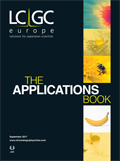SEC-MS Analysis of a Bispecific Antibody
Modern therapeutic antibody formats, such as bispecific antibodies (bsAbs), are on the rise. Bispecific antibodies are artificial proteins that recognize two different epitopes and can simultaneously bind to two different types of antigen. They can be used to redirect T cells to tumour cells, block two different signalling pathways simultaneously, dually target different disease mediators, and deliver payloads to targeted sites.
Tosoh Bioscience GmbH
Modern therapeutic antibody formats, such as bispecific antibodies (bsAbs), are on the rise. Bispecific antibodies are artificial proteins that recognize two different epitopes and can simultaneously bind to two different types of antigen. They can be used to redirect T cells to tumour cells, block two different signalling pathways simultaneously, dually target different disease mediators, and deliver payloads to targeted sites.
Size-exclusion chromatography (SEC) coupled with mass spectrometry (MS) is increasingly being used to identify the accurate molecular mass of biomolecules. SEC-MS, however, requires the use of volatile mobile phases and the use of columns that do not exhibit particle shedding, which will interfere with the MS signal. In this application note, a bispecific T cell engager (BiTE®) consisting of two single-chain variable fragments (scFvs) recombinantly linked by a nonimmunogenic fiveâamino-acid chain (Figure 1) was analyzed by SEC-MS using a TSKgel® UP-SW3000, 2-μm column.

Material and Methods
Column: 4.6 mm × 30 cm, 2-μm TSKgel UP-SW3000
UHPLC instrument: Nexera® XR UHPLC system
MS instrument: Q Exactive™ Plus
Mobile phase: 20 mmol/L ammonium acetate, 10 mmol/L, ammonium bicarbonate; pH 7.2
Flow rate: 0.35 mL/min
Detection: UV @ 280 nm
Temperature: 30 ºC
Injection vol.: 5.0 μL
Samples: BiTE, 0.3 mg/mL (Creative Biolabs)
Ionization mode: Electrospray ionization, positive mode
MS mode: Scanning, m/z 800–6000
Results and Discussion
The ~55 kDa BiTE was injected onto a TSKgel UP-SW3000 column coupled to a Q Exactive Plus mass spectrometer for molar mass determination. Figure 2 shows the (a) total ion chromatogram, (b) mass spectrum, and (c) deconvoluted mass spectrum of the BiTE. A main peak can be seen at m/z 54.143; adjacent peaks at m/z 54.181, 54.219, and 54.086 correspond to different salt adducts.

These results demonstrate accurate molar mass determination for the BiTE utilizing a volatile mobile phase with SEC-MS compatibility. The total ion chromatograms of blank injections prior to injection of the first sample and in between injections of different analytes proved that there is neither shedding from the stationary phase nor sample carryover (data not shown).
Conclusion
The TSKgel UP-SW3000, 2-μm SEC column can be used as a platform method for bispecific antibody accurate mass determination using SECâMS. A MS-compatible mobile phase under nondenaturing condition was successfully used with the TSKgel UP-SW3000 column.
SEC-MS analysis was performed by the Wistar Proteomics and Metabolomics Facility (Philadelphia, Pennsylvania, USA).
TSKgel and Tosoh Bioscience are registered trademarks of Tosoh Corporation.
BiTE is a registered trademark of Amgen Inc.
Nexera is a registered trademark of Shimadzu Corporation.
Q Exactive is a trademark of Thermo Fisher Scientific Inc.

Tosoh Bioscience GmbH
Im Leuschnerpark 4 64347 Griesheim, Darmstadt, Germany
Tel.: +49 6155 7043700 Fax: +49 6155 8357900
E-mail:info.tbg@tosoh.com • Website:www.tosohbioscience.de

Characterizing Plant Polysaccharides Using Size-Exclusion Chromatography
April 4th 2025With green chemistry becoming more standardized, Leena Pitkänen of Aalto University analyzed how useful size-exclusion chromatography (SEC) and asymmetric flow field-flow fractionation (AF4) could be in characterizing plant polysaccharides.
Investigating the Protective Effects of Frankincense Oil on Wound Healing with GC–MS
April 2nd 2025Frankincense essential oil is known for its anti-inflammatory, antioxidant, and therapeutic properties. A recent study investigated the protective effects of the oil in an excision wound model in rats, focusing on oxidative stress reduction, inflammatory cytokine modulation, and caspase-3 regulation; chemical composition of the oil was analyzed using gas chromatography–mass spectrometry (GC–MS).










